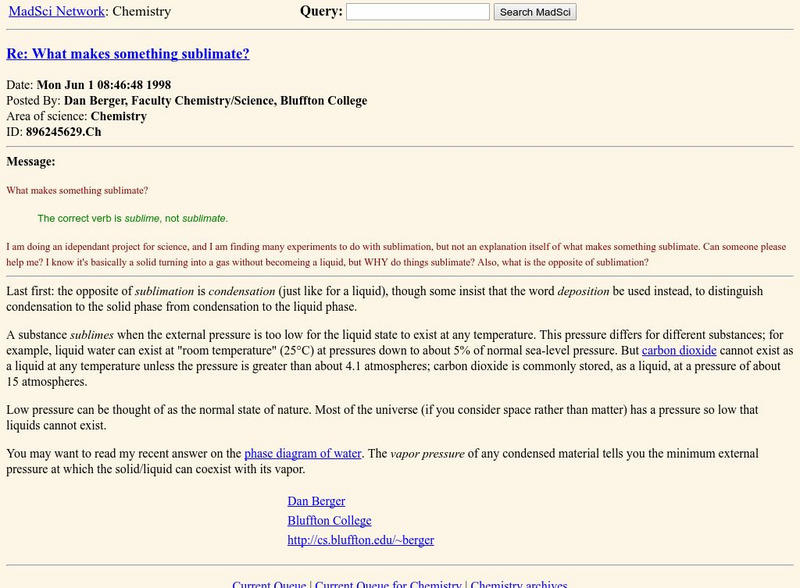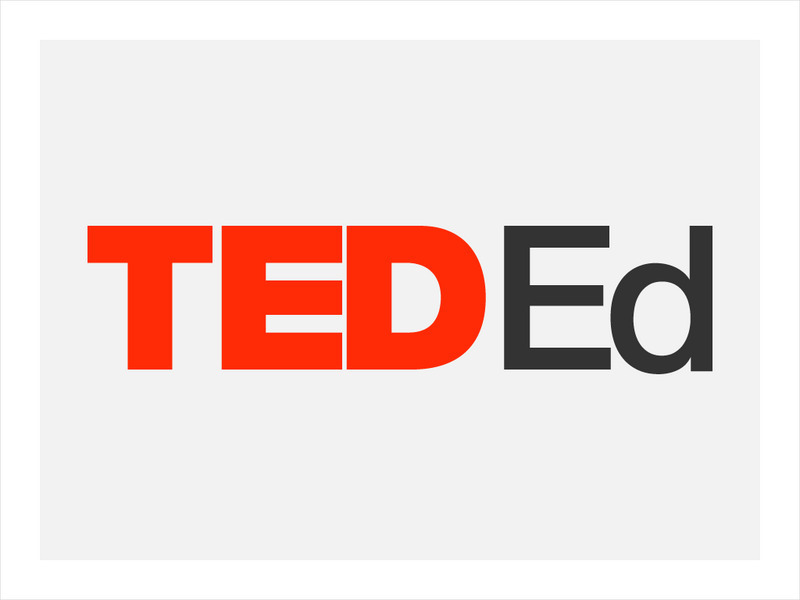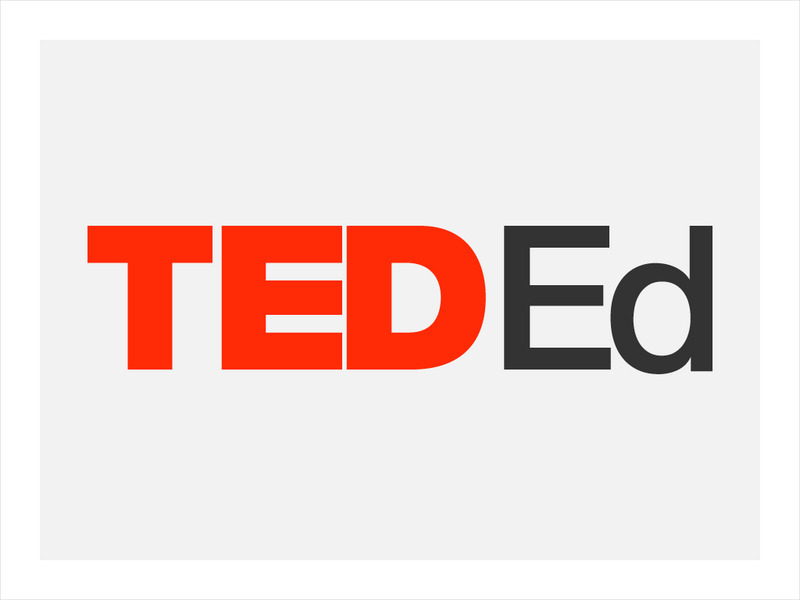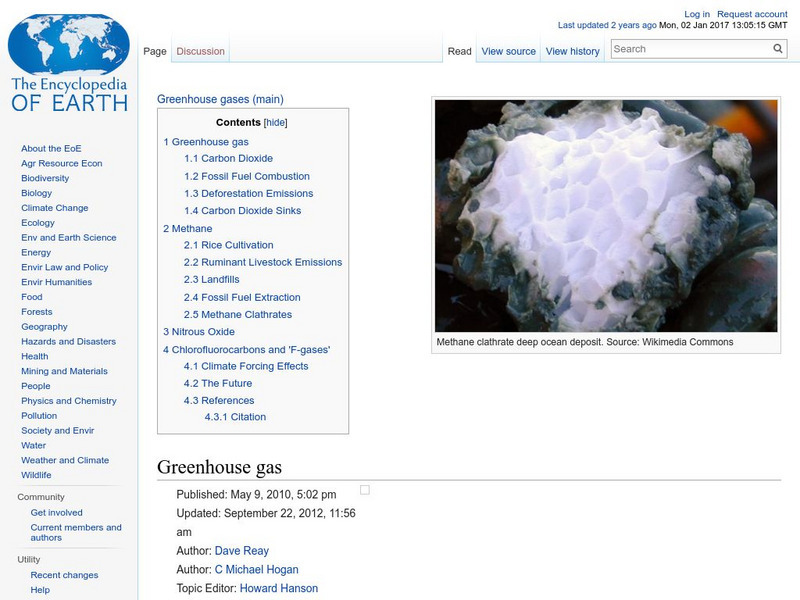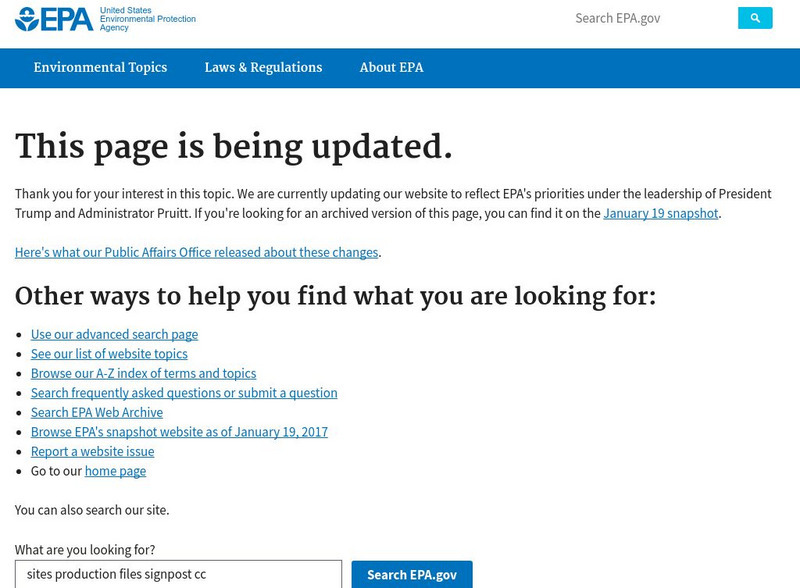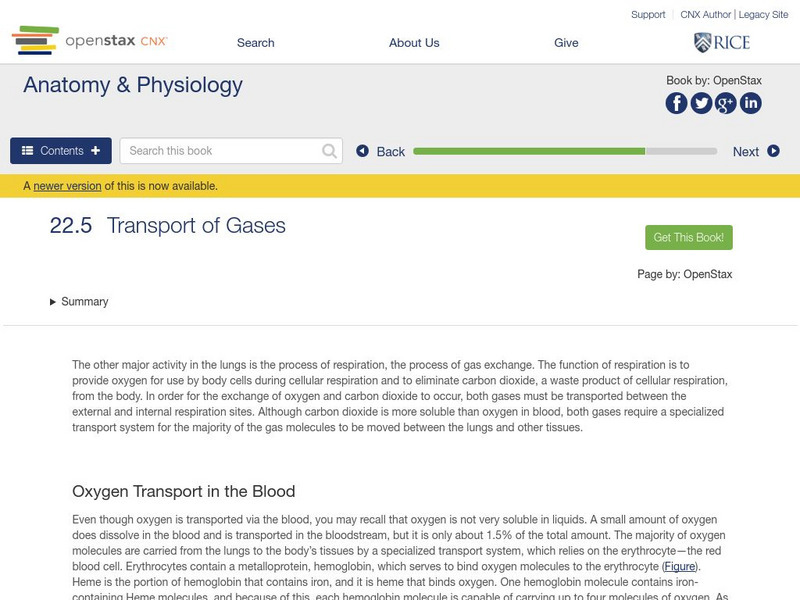Curated OER
Mussel Your Way Through Photosynthesis
Pupils, using zebra mussels (Dreissena polymorpha), elodea and an indicator dye, observe and record the role of light in photosynthesis. They consider plant production of carbon dioxide and the use of live materials in biological research.
MadSci Network
The Mad Scientist Network: Chemistry
The question: "What makes something sublimate?" is discussed and explained. Project ideas pertaining to sublimation are suggested.
McGraw Hill
Online Learning Center: Respiration
This is a very detailed site on breathing/respiration. It covers system organization, mechanics, exchange of gases, and oxygen transport. A very thorough site.
PBS
Pbs Learning Media: Acids and Bases: Making a Film Canister Rocket
ZOOM cast members mix different amounts of baking soda and vinegar to see which combination produces the most carbon dioxide for launching a film-canister rocket. [3:23]
TED Talks
Ted: Ted Ed: How Breathing Works
This video describes how the process of breathing in the human body works. [5:19] Includes a brief quiz and a list of additional resources to explore.
TED Talks
Ted: Ted Ed: James Balog: Time Lapse Proof of Extreme Ice Loss
In this video, James Balog describes how evidence for glaciers receding due to climate change can be seen through time-lapse photography. [19:20] Includes a brief quiz and a list of additional resources to explore.
Environmental Education for Kids
Eek!: Activity: Trees and Air Quality
Site offers lessons and activities designed to supplement study of the environment and ecology. Concise explanations are presented on the importance of trees in our world. Also, problem solving and creative thinking is encouraged...
Science Buddies
Science Buddies: Effects of Exercise: Changes in Carbon Dioxide Output
Everybody knows that your body needs oxygen to keep going, and that you breathe out carbon dioxide as waste. What happens when you exercise? You've probably noticed that you breathe faster, and your heart beats faster. What triggers your...
Science Buddies
Science Buddies: How Does a Chick Breathe Inside Its Shell?
Whether a chick can breathe inside its shell is an interesting question. Every animal needs oxygen to survive, so the chick must get air somehow. Try this science project to discover if the pores in a chicken egg shell allow water to...
Science Buddies
Science Buddies: Swimming in Acid: Understanding Ocean Acidification
The oceans are a precious natural resource, part of Earth's carbon cycle. But what happens if the oceans absorb too much carbon dioxide? Many scientists are concerned that the increased absorption of carbon dioxide is causing them to...
Encyclopedia of Earth
Encyclopedia of Earth: Greenhouse Gas
Explains what greenhouse gas is, how the greenhouse effect works, and the history of fossil fuel combustion. Causes of other damaging greenhouse gases, including methane, nitrous oxide, chlorofluoracarbons, hydrofluorocarbons, and...
American Chemical Society
Middle School Chemistry: Carbon Dioxide Can Make a Solution Acidic
Students explain that carbon dioxide from any source reacts chemically with water to form carbonic acid. They will also be able to use the color changes of universal indicator to monitor the changing pH of a solution during a chemical...
Vision Learning
Visionlearning: Atmosphere and Oceans: Composition of Earth's Atmosphere
An explanation of the different parts of the atmosphere and how pressure and temperature changes at different altitudes.
Climate Literacy
Clean: Effects of Increased Co2 in the Air on Seawater and Distilled Water
Students perform an experiment comparing the impacts of CO2 on salt water and on fresh water. In a short demonstration, students examine how distilled water and seawater are affected differently by increasing carbon dioxide in the air.
Science Education Resource Center at Carleton College
Serc: Connecting Global Climate Change With Engineering
A short series of lessons that explore the importance of engineering solutions to the management of climate change, by brainstorming ways to remove CO2 from the atmosphere and store it in a form that does not promote global warming.
Climate Literacy
Clean: Climate Feedback Loops
This is the seventh of nine lessons from a student learning module called "Visualizing and Understanding the Science of Climate Change." This lesson addresses climate feedback loops and how these loops help drive and regulate Earth's...
US Environmental Protection Agency
Epa: Global Climate Change: All About Carbon Dioxide
Understand the process that must occur to create carbon dioxide. What is the role of carbon dioxide in our atmosphere? A video illustrating the carbon cycle is available.
Other
Inside the Human Body: The Respiratory System
This site has respiratory system activities and learning games for students at all grade levels.
University Corporation for Atmospheric Research
Ucar: Project Learn: Where in the World Is Carbon Dioxide?
For this lesson on greenhouse gas, students conduct experiments to detect and collect carbon dioxide, then use titration to determine how much carbon dioxide is present in an indicator solution.
Nature Conservancy
Nature Works Everywhere: Urban Trees
Understand how trees clean the air making it better for us to breathe. Check out a video and two lesson plans.
OpenStax
Open Stax: Anatomy & Physiology: Transport of Gases
Students learn the principles of oxygen and carbon dioxide transport within the human body, and understand the structure of hemoglobin.
TeachEngineering
Teach Engineering: Hot Stuff!
Students observe demonstrations, and build and evaluate simple models to understand the greenhouse effect and the role of increased greenhouse gas concentration in global warming.
Woods Hole Oceanographic Institution
Woods Hole Oceanographic Institution: Global Carbon Cycle
Interactive learning activity examines the global carbon cycle and describes the exchanges of carbon between the Earth's atmosphere, oceans, land and fossil fuels.




